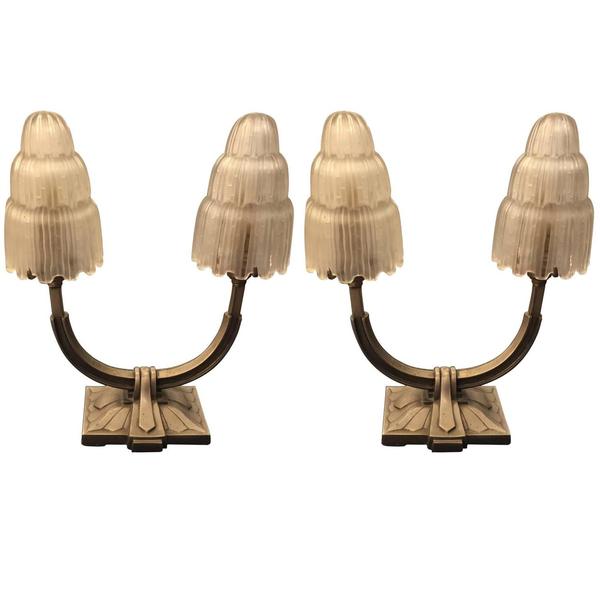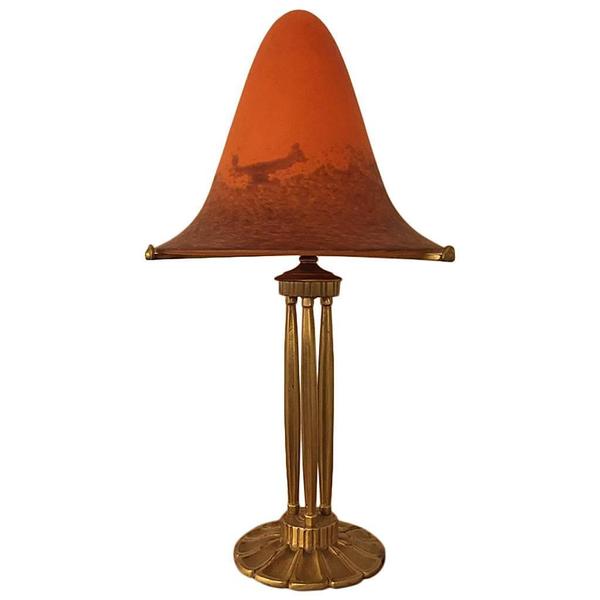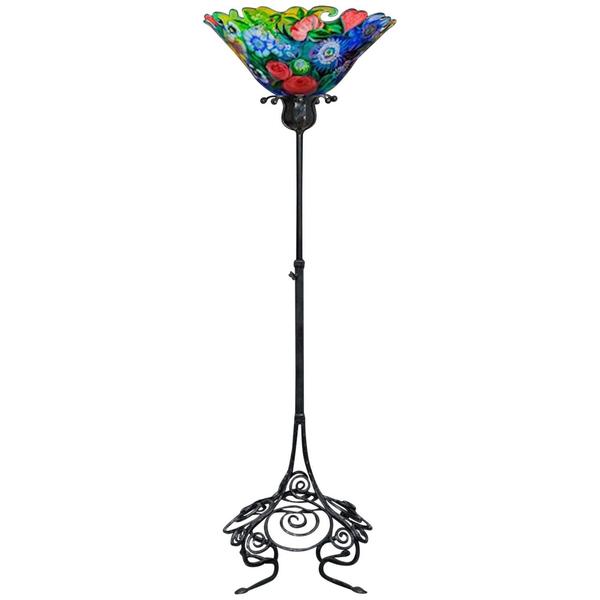4 Tips to Caring for Your Chandelier 0
Taking care of a chandelier can be a tricky job, especially if it's an original and not a replica or knock-off. To keep your chandelier (or chandeliers) in beautiful and great condition, here are 4 tips to follow.
1. Weekly dusting
Chandeliers are notorious dust-traps, attracting dust and insects all the time. They can quickly get dull and the light can become dimmer over time as a result.
Don't just wave a duster at it though, as the dust will simply fly into the air and resettle on your chandelier. Use a soft cloth or a static-free duster every week to remove excess dust, and don't be afraid to get on a ladder and get up close and personal.
Whatever you do, just be careful and, if you are using a ladder, make sure it's secure and there's someone nearby to help stabilize you.
2. Monthly inspections
The older a piece is, the more susceptible it is to rust, temperature fluctuations and other potential damage. It's a good idea to inspect the chandelier once a month, or at least once every two months.
Check any glass, crystal or perspex pieces for chips and cracks. Take a look at (but please don't touch!) the wiring to make sure nothing has become frayed or exposed.
Also look at any metal part, including chains, hooks or links, to make sure they aren't bent, broken or rusted.
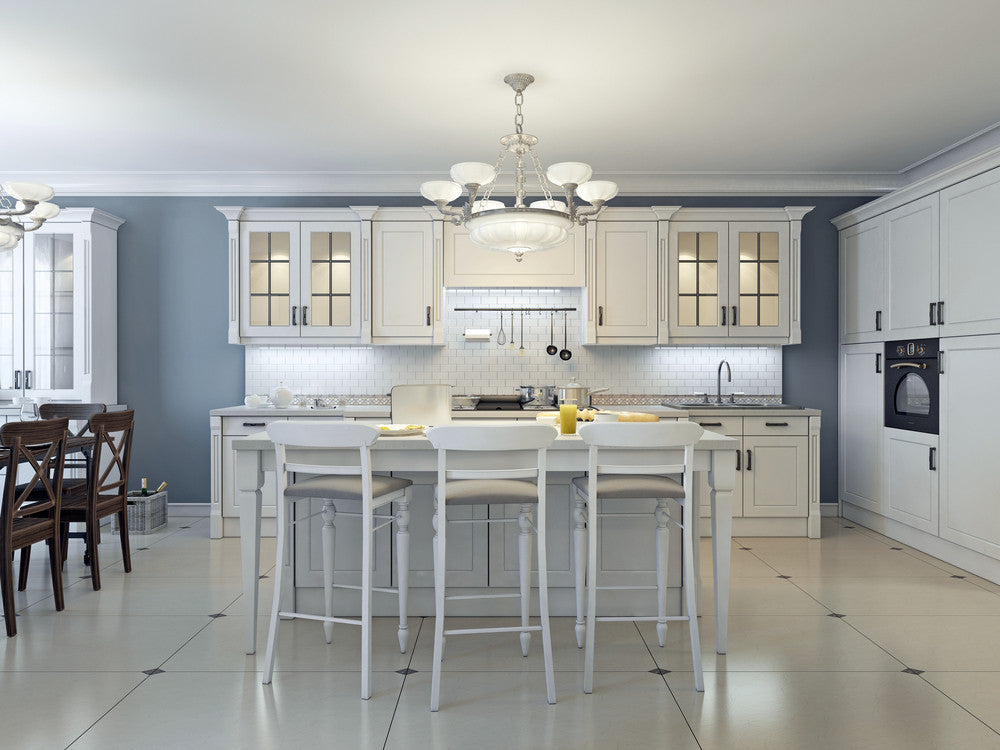
3. Seasonal deep cleaning
This is something that should be done seasonally, or at a minimum every six months.
The more intricate the chandelier and the more pieces it has, the less often you may want to do it to avoid accidentally breaking parts.
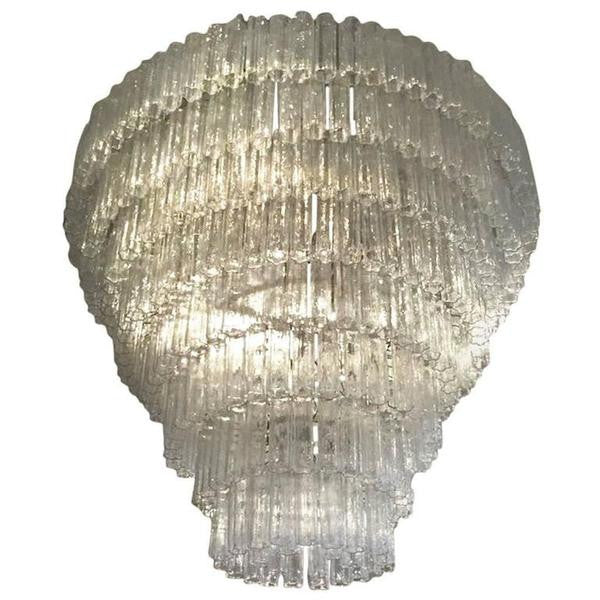
Italian Mid Century Round Eight Tired Tronchi Chandelier
If your chandelier includes many glass, crystal or perspex parts, you'll want to carefully wash those in warm, soapy water every three to six months.
The timing can also depend on where in the house the chandelier is - for example, those in the kitchen will build up humidity and grease a lot more quickly that those in the bedroom.
Take your time dismantling and washing the pieces, then reassemble it when everything is completely dry. If the ceramic or other hardware parts are fragile, very delicate or have any age damage, you'll want to do this process less often.
4 - Call a professional
While it's admirable to take personal care of your Art Deco or Mid-Century Modern chandelier, there's absolutely no reason not to use a professional for the cleaning.
We're quite confident anyone should be able to manage the dusting, but maintenance and deep cleaning can present challenges for non-experts.
French Art Deco Brass and Nickel Chandelier
Get to know the materials your chandelier is made out of and learn what cleaning products are best suited to their care.
Remember that vintage and antique pieces will be made from different materials, or that the materials will have undergone different processes to modern pieces, and this can affect their cleaning and maintenance needs.
If you have any doubt at all, go ahead and call in a professional. The store where you bought your genuine Art Deco or Mid-Century Modern chandelier should have a list of providers they trust to take care of their pieces, and will happily recommend them to you.
Keep Your Lights Shining Bright 0
A 1-2-3 guide to cleaning and caring for Art Deco chandeliers, light fittings and lamps
Bronze
So you've finally chosen and installed your Art Deco lighting. You're surrounded by the soft, gentle glow of sconces, ceiling lights and table lamps that reflect your love for this fantastic decor art form.
But, like everything else, they will get dusty and dirty over time and cleaning them may take a little more care than ordinary light fittings. This step-by-step guide will help you take care of your lights and keep them shining.
Step 1: Know your materials
Glass and Silvered Bronze
Art Deco as a design form drew its influences from all over the world and, as a result, its materials came from every conceivable available source - glass, metal, wood, bone, ceramics and fabric could all quite happily coexist in one piece.
One thing you won't find a lot of in genuine Art Deco is plastic, as most polymers only came into use after World War II, but you may find one or two pieces made of Bakelite.
When buying cleaning products to use on your Art Deco pieces, make sure you are buying the appropriate products - pewter cleaner is no good for wood, while wood polish could wreck your beautiful hand-painted glass shade.
If in doubt, ask the seller or an antiques expert to help you identify the various materials.
Step 2: Careful cleaning
Glass and Copper
The easiest way to keep your lights clean is to dust them regularly. Using a soft cloth, wipe them down gently. Don't use a duster, because all the dust will just fly into the air to settle back on the fittings minutes later.
Even with regular dusting, you will still need to occasionally give your pieces a thorough cleaning. Once every six months to once a year should do it, unless you live in a particularly dusty or smoggy area.
Before washing any part of your lamp, such as the glass, crystal or ceramic parts, check it thoroughly for cracks, chips or other damage - especially in the glaze on ceramics. It is very difficult to get such cracks properly dry and this could cause all kinds of further damage.
Make sure you spend some time gently cleaning all the corners, crevices and nooks where grime can accumulate. Use soft cloths, q-tips or very soft-bristled brushes.
Double-check whether wooden parts are varnished or raw. They may need oil rather than polish. If you use oil, stick with oil; if you use wax, stick with wax. Don't switch between the two, as this can cause cloudiness and build-ups.
Step 3: Don't DIY
Painted Glass and Hand-Forged Iron
When the time comes to take down your enormous crystal and pewter chandelier to individually clean all 500 pieces, or when your hand-painted one-of-a-kind sconces are looking a bit dull and you want to give them a wash, don't.
The same goes for those ceramic pieces with the cracked glaze we talked about earlier, or the carved bone filigree piece with thousands of pin-prick holes.
When it comes to the more specialized pieces, if you have even an ounce of doubt, it's better to leave it to the professionals. Genuine Art Deco pieces are usually quite pricey and unique, so it's worthwhile knowing one or two expert cleaning services to help you.
Make sure they really know the style and don't be afraid to ask them for references - and to contact the references! And also feel free to ask them about maintenance between the annual big clean. They will offer the best and most accurate advice.
- Matthew Pillet
- Tags: art deco ceiling light chandelier cleaning french art deco interior design lamp lighting painted glass sconce stained glass
A Brief History of Art Deco Chandeliers 0

Art Deco is certainly a style on its own, one that stands out among the various styles of the twentieth century and one that persists as a viable decor option even today.
In the same way, chandeliers are a decor and design item all to themselves. Any home can certainly have perfectly adequate and even beautiful lighting without one, but a chandelier brings a unique touch of style to a room, anchoring its decor in a way no other item can.
From simple to ornate...

When they made their appearance in medieval times, chandeliers were simple wooden crosses to which candles could be affixed and which could be transported from room to room.
Over time and as artisans developed new techniques in metal work, glass blowing, crystal cutting, chandeliers became more ornate, larger and more intricate. Of course, this also meant they became more expensive and therefore only afforded by the rich, or appearing in larger churches and cathedrals.
Chandeliers quickly became synonymous with wealth and status, something to aspire to. Stately homes' ceilings would virtually groan under the weight of glass, crystal, metal and candles and later gas-fired and eventually electric chandeliers.
... and back again

Right up until the early twentieth century, this was the status quo... and then came along our favorite decor movement which, naturally, turned everything on its head.
Yes, the ornate and stately chandeliers found new life in Art Deco styles, but simpler, more modern and streamlined designs also made their appearance. Here were chandeliers that could fit into more ordinary homes and lend them a touch of opulence and style without literally taking over the room.
These paved the way for the Mid-century Modern low-hanging single-fitting light fixtures and the enormous variety of home chandeliers we see today. But of course, a special place in our hearts will always belong to these pioneers of design and lighting style.
If you want to add some Art Deco chandelier action to your home, take a few things into consideration.
Size matters
Larger rooms can, of course, accommodate larger chandeliers, but bear in mind the height of the ceiling, not just the floor area. The last thing you want is your guests banging their heads on your lovely lighting.
For a smaller room, consider something like this French Art Deco Modernist Ceiling Light Chandelier, which is gorgeous and true to the style, but won't dangle in your dinner.

Material world
Art Deco is Art Deco is Art Deco, right? Well, no. As with any design movement, there are sub-styles, items that work together and items that clash.
Especially if you're going the whole hog, it pays to pay attention to the materials you're using and trying to work out which work together and which fall flat. By contrast, you may not want to overdo it on one type of material.
For example, if your room is feeling a little heavy on the polished wood items, consider something like this incredible pressed glass chandelier from the Verrerie des Hanots.

Above all, have fun with your Art Deco stylings. The design movement represented a new era in design, a movement away from the past and into the future, so don't be afraid to experiment with it and make it your own.
- Matthew Pillet
- Tags: art deco ceiling light chandelier french art deco interior design lighting
Art Deco in Hollywood: Three celebrity homes to get lost in 0
Hollywood's love affair with Art Deco is one that goes back to the early days of both art forms. The first movie filmed in Hollywood was filmed in 1910 and by the time the cinema had picked up in popularity, Art Deco was making its first overtures in France and quickly spreading to the USA. The relationship goes so deep that many of the buildings in Hollywood and surrounding Los Angeles are Art Deco style.
Thanks to movies, it is easier to find Art Deco originals and knock-offs. Even Hollywood's most well-known symbol, Oscar, is designed in Art Deco style. It's no surprise then, that many celebrities choose to build and decorate their homes in Art Deco style. This week, we take a peek inside three of these homes that the Art Deco lover could happily get lost in.
Jennifer Aniston: Beverly Hills
When Jennifer Aniston bought a Harold W Levitt house in Beverly Hills, she decided to transform it into an opulent Art Deco palace in which she could comfortably entertain guests in style and privacy. Designer Stephen Shadley was tasked with bringing Jennifer's vision to life and, after virtually rebuilding the house, it was finally revealed in all its glory.

Source: Architectural Digest
Our favourite? The games room, perfectly set up for entertaining and with its stunning view over LA, it's the stuff of Hollywood fantasy.
To spruce up your entertainment area, what about a beautiful buffet?
Jeremy Renner: Holmby Hills
Everyone's favorite hawk-eyed Avenger, Jeremy Renner, has a fun and interesting sideline – buying, renovating and flipping houses, including a stunning mansion in Holmby Hills that he and his business partner, Kristoffer Winters, sold off in 2013.
Priced at just shy of $25 million, they described the home as a "Roaring 20s Art Deco-style home fit for a 21st century Howard Hughes" – and when you take a look inside, you'll agree. It certainly is a home we could comfortably become recluses in.

Source: Business Insider
Our favourite? Definitely the gents' walk-in closet with its own barber chair and station. Nothing quite encourages enjoying one's home more than being able to get your shave and haircut without leaving the house.
Recline in luxury and celebrate your privacy with luxurious club chairs, fit for a king and queen of cool.
Mickey Drexler: Tribeca
Ok, he's not exactly Hollywood, but the incredible Art Deco stylings of J Crew's CEO's New York home are too good to skip on a technicality.
Drexler went straight to the source for the full-scale rebuild and design of his home – French architect and designer Thierry Despont. Filled with French Art Deco inspiration, including the Maison de Verre in Paris, this five-bedroom former factory is an Art Deco paradise.

Source: Elle Decor
Our favorite? This bedroom. It is flawless Art Deco, from the step-and-repeat wallpaper, to the trimmed pillow covers, to the poster flanked by the symmetrically asymmetrical picture frames containing Art Deco images... this room is a masterpiece and we could happily spend days on end here.
Just because sleep is a necessity doesn't mean it can't also be a luxury. Cradle yourself in style with an Art Deco bed.
- Matthew Pillet
- Tags: art deco french art deco
Art Deco How-to Guide: 4 Easy Décor Ideas 0

Ah, Art Deco – that beautiful, functional, stylishly retro art and décor that exudes a feeling of opulent modernity and harks back to an era of carefree abandon and joy in progress. It's a style reflected in Old Hollywood's glamour, in Frank Lloyd Wright's architectural marvels and in the iconic and much-copied fashion drawings of Erté.
We've seen it in a host of movies and TV series – from Boardwalk Empire to American Horror Story – and its legacy lives on in some of the most well-known buildings around the world.
If you've developed a bit of a hankering to surround yourself with a little old-style glamour after watching The Great Gatsby or bingeing on Bogey and Bacall, we certainly can't blame you.
But where to start? Do you redecorate your entire house to look and feel just like a movie set, or do you start slowly, with a few select pieces? If you want to go all the way, we can, of course, help; but if you want to take it slow, ease into it nice and languid-like, we have a few tips on how to get started on your Art Deco journey.
Choose function over form
While innovative design was at the very heart of Art Deco, one of its defining characteristics is that most of its elements are functional as well as beautiful. So, rather than choosing a statuette, choose an item that serves a purpose, too. You could try a matching pair of table lamps, a useful coat rack, an accent table or a stylish mirror.
1. Shed some light on it
One of our favorite ways to introduce a bit of Art Deco to your life is through lighting. It's not as overwhelming as changing all your furniture, but it still adds that touch of opulence to your space. With a little attention to detail, you can replace your existing wall sconces with gorgeous Art Deco sconces, turning your room's lighting into something you don't just use to see by, but something to look at, too.

2. Hang your hat on it
Grab guests' attention the minute they step in the door with an eye-catching coat rack or hall tree. The epitome of form meeting function, this piece can set the tone and serve as a great introduction into the world of Art Deco.
3. Somewhere to put your "cuppa joe"
If you're feeling a little more adventurous and want to get into Art Deco furniture straight away, you can't go wrong with a good accent table – it will give you somewhere to put the elephant wine cooler when you throw a lavish party.
4. Look yourself in the kisser

Mirrors can be the aspiring Art Decorator's best friend. Not only does a mirror add depth and dimension to any space, but a beautifully crafted Art Deco mirror can jazz up the room – plus it gives you somewhere to check the cut of your zoot suit, or make sure your feather boa's lying just so.
These are just a few short little tips on how to take the first steps. We are sure you're going to enjoy your journey into the world of Art Deco. Stay in touch for more ideas.
- Matthew Pillet
- Tags: art deco french art deco
An Introduction to Art Deco 0
Early Twentieth Century Art and Décor
The late nineteenth and early twentieth centuries’ artistic landscapes throughout Europe and North America were heavily influenced by the beautiful, flowing forms of Art Nouveau, which permeated design, architecture and furniture. Art Nouveau loved and celebrated the organic and drew inspiration from nature.

In 1925, however, the Exposition Internationale des Arts Décoratifs Industriels et Modernes in Paris introduced a new term – Art Deco – for the up-and-coming trend that took these organic forms into the realm of the modern and scientific, becoming the stepped geometric patterns that would utterly transform and dominate art and design over the course of the next few decades. The trend had slowly been building momentum since the end of World War I, as people embraced Cubism and Neoclassicism, in a bid to leave behind the distresses of war and to move forward into the new, fresh and modern. Angular forms, geometric shapes and repeating designs took over architecture, breathing new life into a shattered Europe.
Influences on Art Deco and Its Development
Between the two World Wars, Paris life was all about glamour. Movies were becoming popular, beauty was de rigueur and old-fashioned just wouldn’t do. Artistic movements like cubism and fauvism were gaining traction; jazz music was heard in every café, night spot and home; in England and America, writers like PG Wodehouse and F Scott Fitzgerald were telling the stories of the rich and frivolous; and architects like Le Corbusier were replacing buildings decimated just a few years earlier with elegant and opulent constructions – many of which stand today.

Art Deco’s history goes back a little further, however, than just to the end of World War I. In 1900, the Société des Artistes Décorateurs (the Society of Artist-Decorators) was formed in France as a response to the waning interest in French design. Innovations in architecture and design were crossing the globe, originating from such far-flung places as Australia, and France was losing relevance as a design leader. The French sought to reclaim this throne and went as far as to gain government sponsorship for an exhibition that would showcase the talents and works of members of the Société. The exhibition was scheduled to take place in 1915, but was postponed until the end of the war and only took place a decade later.

The mandate for this exhibition was clear – France wanted to reign supreme once again as world leaders in luxury, and this position had to be reclaimed not through a rehashing of the old, but by introducing something new and revolutionary to the world. Historical styles were shunned; applications were broad, covering everything from table lamps to entire buildings; and art was not created for its own sake, but as part of an overall decorative scheme which found its way into all manner of objects. The style was embraced and adopted throughout the modern world. Examples of Art Deco buildings can still be found in major cities in Europe, the Americas, Australasia, even Africa – take the famed Chrysler building as just one example, the Paris Metro station entrances that have remained unchanged and instantly recognizable for over a century, and even the famed statue of Christ the Redeemer in Rio de Janeiro.
Recognizing Art Deco
Art Deco may have drawn some of its influences from Cubism and it shared its time with other movements like Bauhaus, Art Moderne and Arts and Crafts, all of which share at least some characteristics. To recognize Art Deco, it helps to keep a few details in mind – although these are not, as it were, carved in stone.

Because it was a celebration of the modern, of science and technology, geometric shapes feature heavily, especially in symmetrical, repeating arrangements. Contrasting, vibrant colors abound, as does the use of various different, often seemingly incompatible, materials. The modern age allowed the Art Deco movement to combine metals and plastics with glass and wood, often in one contiguous piece. As opposed to Art Nouveau’s true-to-life incorporation of all things natural, including birds, leaves, flowers and so on, when natural elements found their way into Art Deco, they were stylized, made symmetrical and given the same repeating motif treatment as triangles, rhomboids, diamonds, sine waves and more.

Surfaces and fabrics are polished and shiny – including highly polished woods, metals and glass – while lighting is subdued, adding warmth, glamour and opulence. While patterns may be stark and lacking in frill, they are nonetheless lavish and eye-catching, right down to the floors covered in their perfect parquet. Art Deco did not aim to be subtle, background design – it was designed to be noticed, talked about and enjoyed for itself. Art Deco is also less prevalent in the visual arts and is primarily found in architectural applications and furniture. As a style, it is more recognized as a functional art form than as a purely decorative one, despite its name.
Art Deco in Today’s World

Art Deco’s heyday was brief, lasting for just the decade and a half between the end of World War I and the outbreak of World War II. Nonetheless, its influences can still be seen all around us today. Television series like Downton Abbey and movies like The Great Gatsby bring the opulence of classic Art Deco style into our view and the immense popularity of these shows and movies are probably at least partly to thank for the influence that Art Deco is having on contemporary art.

At the moment, in interior design, we are seeing more monochrome, symmetrical patterns as well as bold combinations with metallic elements. Step and repeat patterns can be found in flooring, on furnishings and in molded ceilings. Unnecessary frou-frou is being trimmed down and furniture is taking on cleaner lines and echoing the shiny, polished surfaces of classic Art Deco.

- Matthew Pillet
- Tags: art deco french art deco


